Tort Law Case Study: Negligence in Australian Legal System
VerifiedAdded on 2022/10/07
|7
|1822
|52
Case Study
AI Summary
This case study examines the principles of tort law, with a specific focus on negligence within the Australian legal framework. The report begins by outlining the fundamental aims of civil law and defining key terms such as tort and negligence. It then details the three essential elements required to establish liability for negligence: duty of care, breach of that duty, and causation leading to damages. The study then analyzes two articles, identifying potential plaintiffs and defendants in each case. Focusing on one article, the case study assesses whether the elements of negligence would likely be established against the defendant, using specific facts from the article to support each element. The analysis includes references to relevant case authorities such as Donoghue v Stevenson and Bolton v Stone, to illustrate and reinforce the legal principles. The report concludes by summarizing the findings and emphasizing the importance of tort law in protecting individual rights and providing remedies for damages caused by negligence.
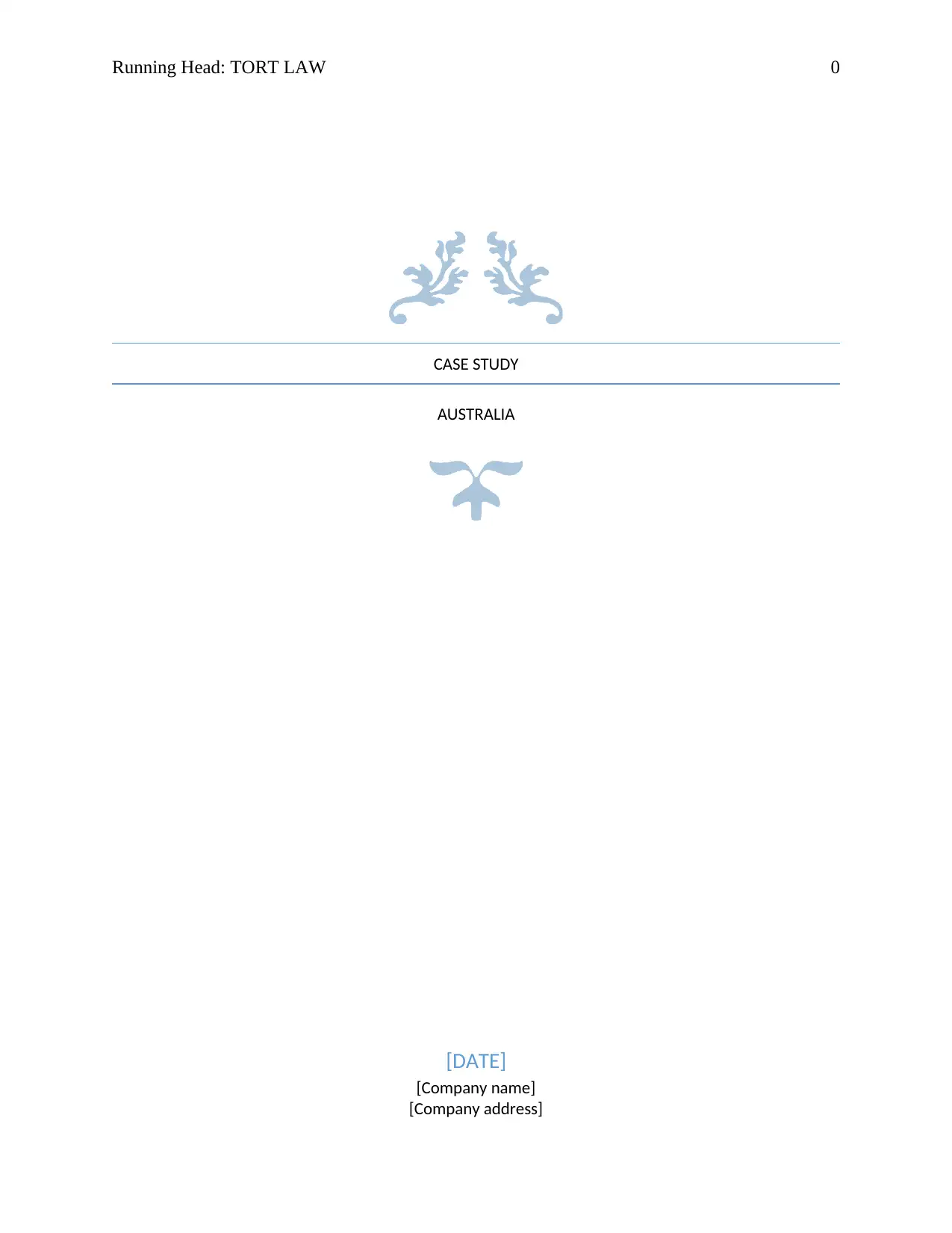
Running Head: TORT LAW 0
CASE STUDY
AUSTRALIA
[DATE]
[Company name]
[Company address]
CASE STUDY
AUSTRALIA
[DATE]
[Company name]
[Company address]
Paraphrase This Document
Need a fresh take? Get an instant paraphrase of this document with our AI Paraphraser
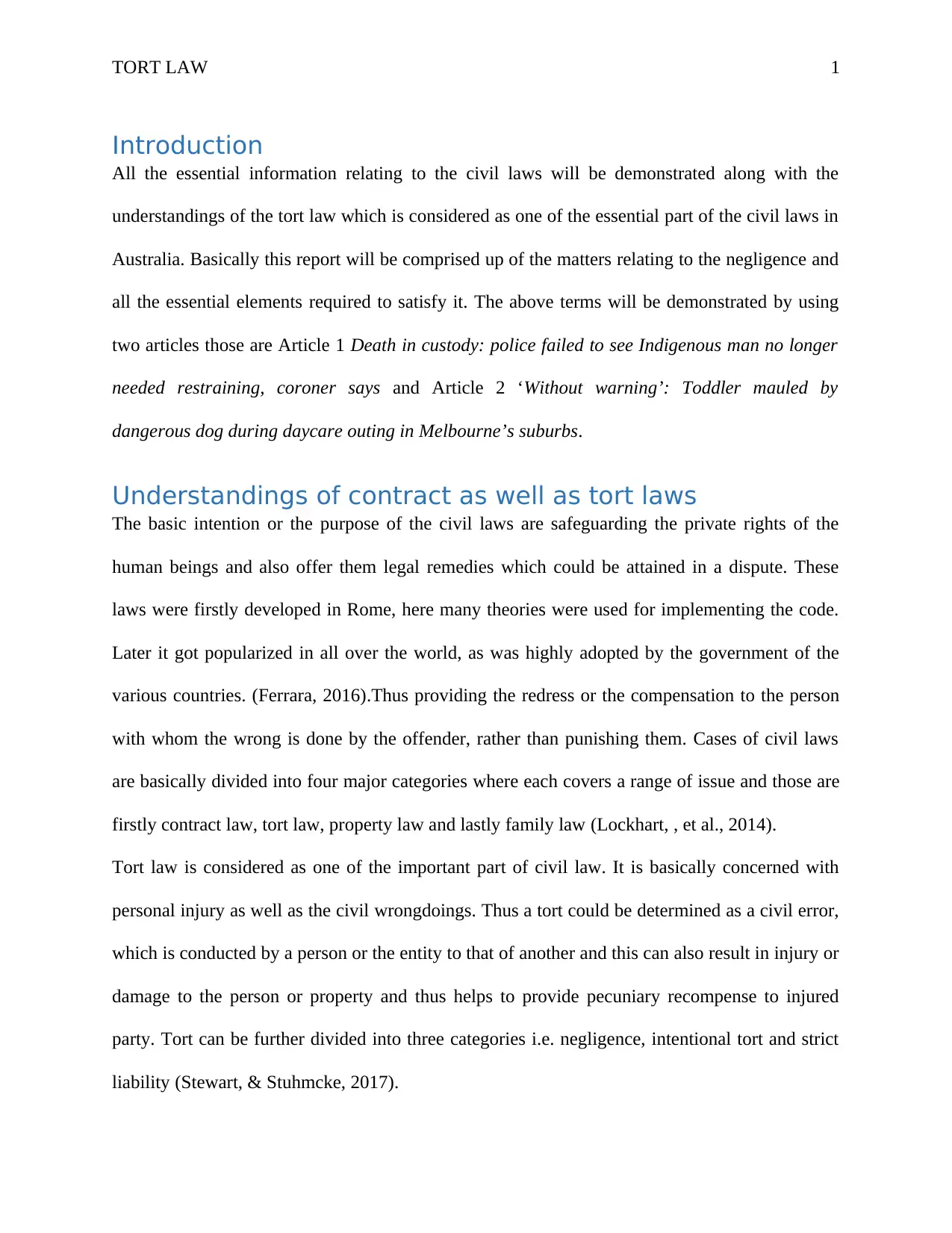
TORT LAW 1
Introduction
All the essential information relating to the civil laws will be demonstrated along with the
understandings of the tort law which is considered as one of the essential part of the civil laws in
Australia. Basically this report will be comprised up of the matters relating to the negligence and
all the essential elements required to satisfy it. The above terms will be demonstrated by using
two articles those are Article 1 Death in custody: police failed to see Indigenous man no longer
needed restraining, coroner says and Article 2 ‘Without warning’: Toddler mauled by
dangerous dog during daycare outing in Melbourne’s suburbs.
Understandings of contract as well as tort laws
The basic intention or the purpose of the civil laws are safeguarding the private rights of the
human beings and also offer them legal remedies which could be attained in a dispute. These
laws were firstly developed in Rome, here many theories were used for implementing the code.
Later it got popularized in all over the world, as was highly adopted by the government of the
various countries. (Ferrara, 2016).Thus providing the redress or the compensation to the person
with whom the wrong is done by the offender, rather than punishing them. Cases of civil laws
are basically divided into four major categories where each covers a range of issue and those are
firstly contract law, tort law, property law and lastly family law (Lockhart, , et al., 2014).
Tort law is considered as one of the important part of civil law. It is basically concerned with
personal injury as well as the civil wrongdoings. Thus a tort could be determined as a civil error,
which is conducted by a person or the entity to that of another and this can also result in injury or
damage to the person or property and thus helps to provide pecuniary recompense to injured
party. Tort can be further divided into three categories i.e. negligence, intentional tort and strict
liability (Stewart, & Stuhmcke, 2017).
Introduction
All the essential information relating to the civil laws will be demonstrated along with the
understandings of the tort law which is considered as one of the essential part of the civil laws in
Australia. Basically this report will be comprised up of the matters relating to the negligence and
all the essential elements required to satisfy it. The above terms will be demonstrated by using
two articles those are Article 1 Death in custody: police failed to see Indigenous man no longer
needed restraining, coroner says and Article 2 ‘Without warning’: Toddler mauled by
dangerous dog during daycare outing in Melbourne’s suburbs.
Understandings of contract as well as tort laws
The basic intention or the purpose of the civil laws are safeguarding the private rights of the
human beings and also offer them legal remedies which could be attained in a dispute. These
laws were firstly developed in Rome, here many theories were used for implementing the code.
Later it got popularized in all over the world, as was highly adopted by the government of the
various countries. (Ferrara, 2016).Thus providing the redress or the compensation to the person
with whom the wrong is done by the offender, rather than punishing them. Cases of civil laws
are basically divided into four major categories where each covers a range of issue and those are
firstly contract law, tort law, property law and lastly family law (Lockhart, , et al., 2014).
Tort law is considered as one of the important part of civil law. It is basically concerned with
personal injury as well as the civil wrongdoings. Thus a tort could be determined as a civil error,
which is conducted by a person or the entity to that of another and this can also result in injury or
damage to the person or property and thus helps to provide pecuniary recompense to injured
party. Tort can be further divided into three categories i.e. negligence, intentional tort and strict
liability (Stewart, & Stuhmcke, 2017).
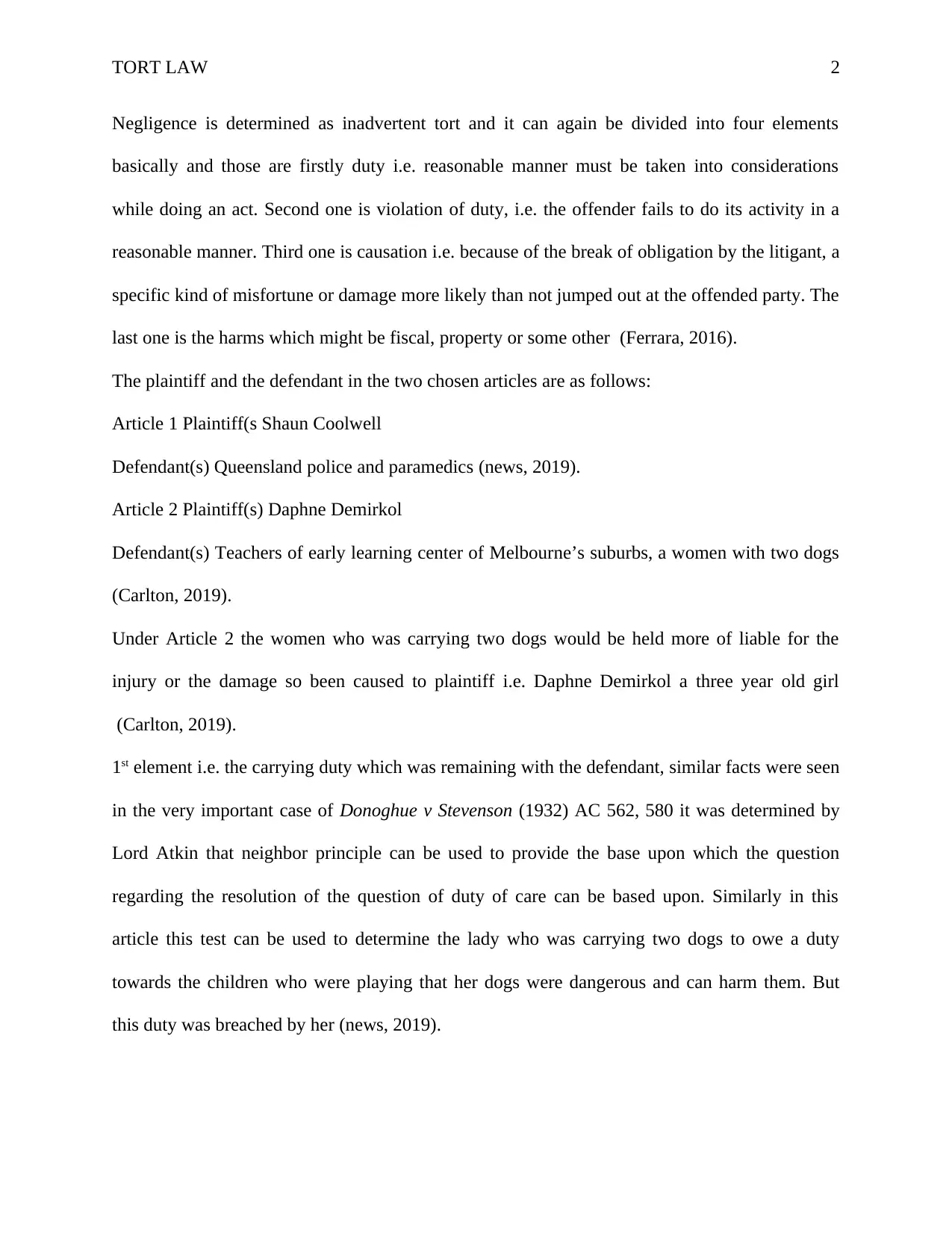
TORT LAW 2
Negligence is determined as inadvertent tort and it can again be divided into four elements
basically and those are firstly duty i.e. reasonable manner must be taken into considerations
while doing an act. Second one is violation of duty, i.e. the offender fails to do its activity in a
reasonable manner. Third one is causation i.e. because of the break of obligation by the litigant, a
specific kind of misfortune or damage more likely than not jumped out at the offended party. The
last one is the harms which might be fiscal, property or some other (Ferrara, 2016).
The plaintiff and the defendant in the two chosen articles are as follows:
Article 1 Plaintiff(s Shaun Coolwell
Defendant(s) Queensland police and paramedics (news, 2019).
Article 2 Plaintiff(s) Daphne Demirkol
Defendant(s) Teachers of early learning center of Melbourne’s suburbs, a women with two dogs
(Carlton, 2019).
Under Article 2 the women who was carrying two dogs would be held more of liable for the
injury or the damage so been caused to plaintiff i.e. Daphne Demirkol a three year old girl
(Carlton, 2019).
1st element i.e. the carrying duty which was remaining with the defendant, similar facts were seen
in the very important case of Donoghue v Stevenson (1932) AC 562, 580 it was determined by
Lord Atkin that neighbor principle can be used to provide the base upon which the question
regarding the resolution of the question of duty of care can be based upon. Similarly in this
article this test can be used to determine the lady who was carrying two dogs to owe a duty
towards the children who were playing that her dogs were dangerous and can harm them. But
this duty was breached by her (news, 2019).
Negligence is determined as inadvertent tort and it can again be divided into four elements
basically and those are firstly duty i.e. reasonable manner must be taken into considerations
while doing an act. Second one is violation of duty, i.e. the offender fails to do its activity in a
reasonable manner. Third one is causation i.e. because of the break of obligation by the litigant, a
specific kind of misfortune or damage more likely than not jumped out at the offended party. The
last one is the harms which might be fiscal, property or some other (Ferrara, 2016).
The plaintiff and the defendant in the two chosen articles are as follows:
Article 1 Plaintiff(s Shaun Coolwell
Defendant(s) Queensland police and paramedics (news, 2019).
Article 2 Plaintiff(s) Daphne Demirkol
Defendant(s) Teachers of early learning center of Melbourne’s suburbs, a women with two dogs
(Carlton, 2019).
Under Article 2 the women who was carrying two dogs would be held more of liable for the
injury or the damage so been caused to plaintiff i.e. Daphne Demirkol a three year old girl
(Carlton, 2019).
1st element i.e. the carrying duty which was remaining with the defendant, similar facts were seen
in the very important case of Donoghue v Stevenson (1932) AC 562, 580 it was determined by
Lord Atkin that neighbor principle can be used to provide the base upon which the question
regarding the resolution of the question of duty of care can be based upon. Similarly in this
article this test can be used to determine the lady who was carrying two dogs to owe a duty
towards the children who were playing that her dogs were dangerous and can harm them. But
this duty was breached by her (news, 2019).
⊘ This is a preview!⊘
Do you want full access?
Subscribe today to unlock all pages.

Trusted by 1+ million students worldwide
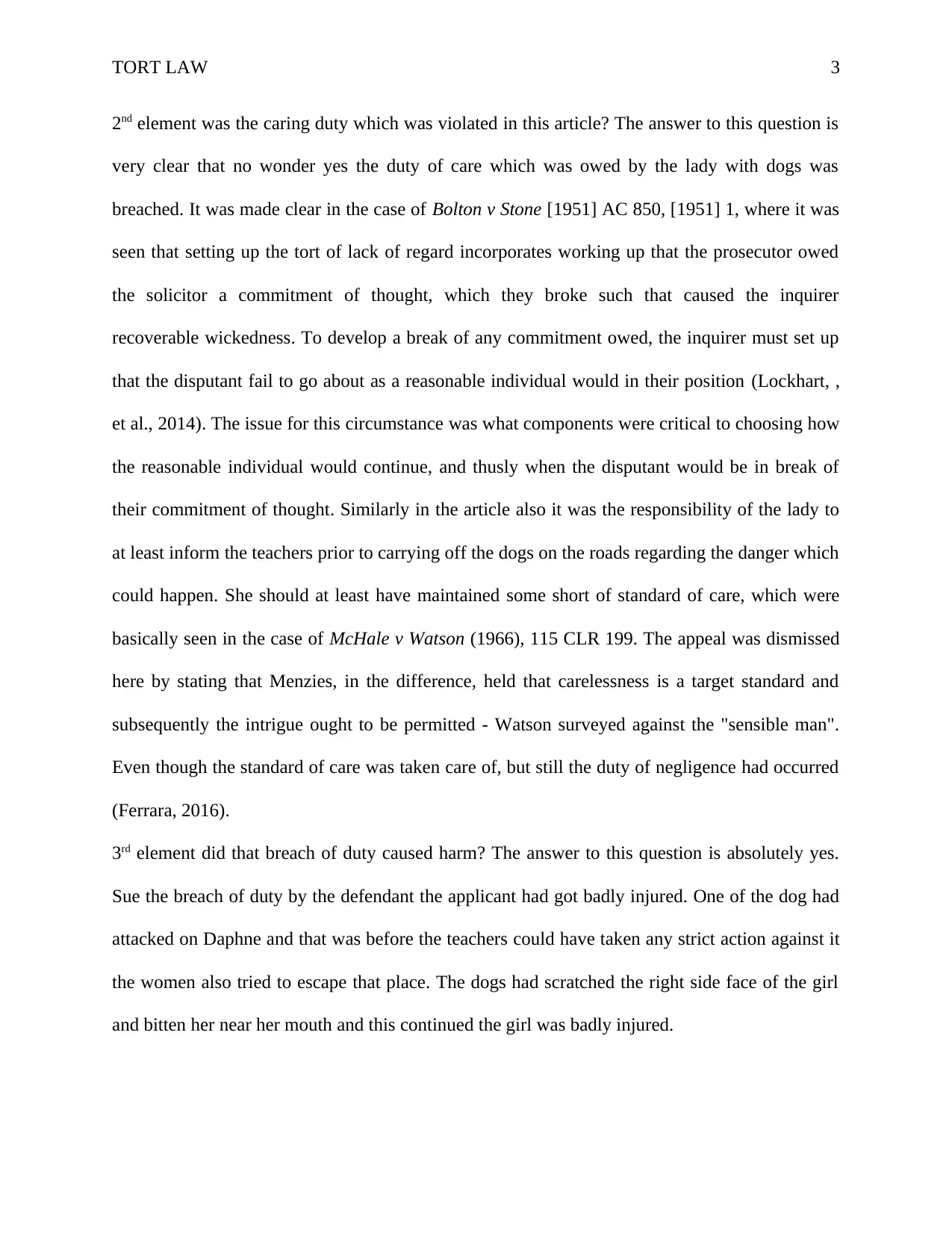
TORT LAW 3
2nd element was the caring duty which was violated in this article? The answer to this question is
very clear that no wonder yes the duty of care which was owed by the lady with dogs was
breached. It was made clear in the case of Bolton v Stone [1951] AC 850, [1951] 1, where it was
seen that setting up the tort of lack of regard incorporates working up that the prosecutor owed
the solicitor a commitment of thought, which they broke such that caused the inquirer
recoverable wickedness. To develop a break of any commitment owed, the inquirer must set up
that the disputant fail to go about as a reasonable individual would in their position (Lockhart, ,
et al., 2014). The issue for this circumstance was what components were critical to choosing how
the reasonable individual would continue, and thusly when the disputant would be in break of
their commitment of thought. Similarly in the article also it was the responsibility of the lady to
at least inform the teachers prior to carrying off the dogs on the roads regarding the danger which
could happen. She should at least have maintained some short of standard of care, which were
basically seen in the case of McHale v Watson (1966), 115 CLR 199. The appeal was dismissed
here by stating that Menzies, in the difference, held that carelessness is a target standard and
subsequently the intrigue ought to be permitted - Watson surveyed against the "sensible man".
Even though the standard of care was taken care of, but still the duty of negligence had occurred
(Ferrara, 2016).
3rd element did that breach of duty caused harm? The answer to this question is absolutely yes.
Sue the breach of duty by the defendant the applicant had got badly injured. One of the dog had
attacked on Daphne and that was before the teachers could have taken any strict action against it
the women also tried to escape that place. The dogs had scratched the right side face of the girl
and bitten her near her mouth and this continued the girl was badly injured.
2nd element was the caring duty which was violated in this article? The answer to this question is
very clear that no wonder yes the duty of care which was owed by the lady with dogs was
breached. It was made clear in the case of Bolton v Stone [1951] AC 850, [1951] 1, where it was
seen that setting up the tort of lack of regard incorporates working up that the prosecutor owed
the solicitor a commitment of thought, which they broke such that caused the inquirer
recoverable wickedness. To develop a break of any commitment owed, the inquirer must set up
that the disputant fail to go about as a reasonable individual would in their position (Lockhart, ,
et al., 2014). The issue for this circumstance was what components were critical to choosing how
the reasonable individual would continue, and thusly when the disputant would be in break of
their commitment of thought. Similarly in the article also it was the responsibility of the lady to
at least inform the teachers prior to carrying off the dogs on the roads regarding the danger which
could happen. She should at least have maintained some short of standard of care, which were
basically seen in the case of McHale v Watson (1966), 115 CLR 199. The appeal was dismissed
here by stating that Menzies, in the difference, held that carelessness is a target standard and
subsequently the intrigue ought to be permitted - Watson surveyed against the "sensible man".
Even though the standard of care was taken care of, but still the duty of negligence had occurred
(Ferrara, 2016).
3rd element did that breach of duty caused harm? The answer to this question is absolutely yes.
Sue the breach of duty by the defendant the applicant had got badly injured. One of the dog had
attacked on Daphne and that was before the teachers could have taken any strict action against it
the women also tried to escape that place. The dogs had scratched the right side face of the girl
and bitten her near her mouth and this continued the girl was badly injured.
Paraphrase This Document
Need a fresh take? Get an instant paraphrase of this document with our AI Paraphraser
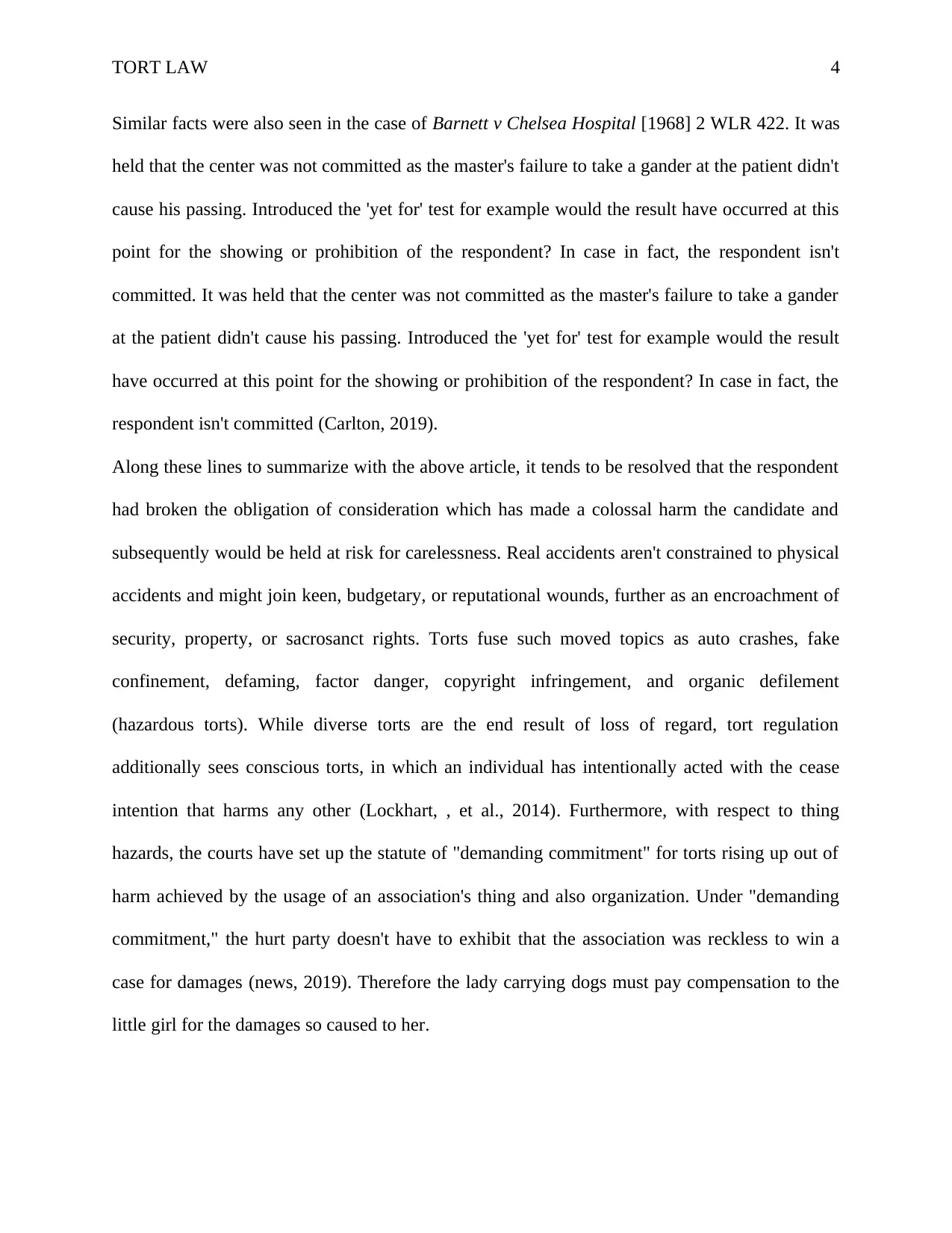
TORT LAW 4
Similar facts were also seen in the case of Barnett v Chelsea Hospital [1968] 2 WLR 422. It was
held that the center was not committed as the master's failure to take a gander at the patient didn't
cause his passing. Introduced the 'yet for' test for example would the result have occurred at this
point for the showing or prohibition of the respondent? In case in fact, the respondent isn't
committed. It was held that the center was not committed as the master's failure to take a gander
at the patient didn't cause his passing. Introduced the 'yet for' test for example would the result
have occurred at this point for the showing or prohibition of the respondent? In case in fact, the
respondent isn't committed (Carlton, 2019).
Along these lines to summarize with the above article, it tends to be resolved that the respondent
had broken the obligation of consideration which has made a colossal harm the candidate and
subsequently would be held at risk for carelessness. Real accidents aren't constrained to physical
accidents and might join keen, budgetary, or reputational wounds, further as an encroachment of
security, property, or sacrosanct rights. Torts fuse such moved topics as auto crashes, fake
confinement, defaming, factor danger, copyright infringement, and organic defilement
(hazardous torts). While diverse torts are the end result of loss of regard, tort regulation
additionally sees conscious torts, in which an individual has intentionally acted with the cease
intention that harms any other (Lockhart, , et al., 2014). Furthermore, with respect to thing
hazards, the courts have set up the statute of "demanding commitment" for torts rising up out of
harm achieved by the usage of an association's thing and also organization. Under "demanding
commitment," the hurt party doesn't have to exhibit that the association was reckless to win a
case for damages (news, 2019). Therefore the lady carrying dogs must pay compensation to the
little girl for the damages so caused to her.
Similar facts were also seen in the case of Barnett v Chelsea Hospital [1968] 2 WLR 422. It was
held that the center was not committed as the master's failure to take a gander at the patient didn't
cause his passing. Introduced the 'yet for' test for example would the result have occurred at this
point for the showing or prohibition of the respondent? In case in fact, the respondent isn't
committed. It was held that the center was not committed as the master's failure to take a gander
at the patient didn't cause his passing. Introduced the 'yet for' test for example would the result
have occurred at this point for the showing or prohibition of the respondent? In case in fact, the
respondent isn't committed (Carlton, 2019).
Along these lines to summarize with the above article, it tends to be resolved that the respondent
had broken the obligation of consideration which has made a colossal harm the candidate and
subsequently would be held at risk for carelessness. Real accidents aren't constrained to physical
accidents and might join keen, budgetary, or reputational wounds, further as an encroachment of
security, property, or sacrosanct rights. Torts fuse such moved topics as auto crashes, fake
confinement, defaming, factor danger, copyright infringement, and organic defilement
(hazardous torts). While diverse torts are the end result of loss of regard, tort regulation
additionally sees conscious torts, in which an individual has intentionally acted with the cease
intention that harms any other (Lockhart, , et al., 2014). Furthermore, with respect to thing
hazards, the courts have set up the statute of "demanding commitment" for torts rising up out of
harm achieved by the usage of an association's thing and also organization. Under "demanding
commitment," the hurt party doesn't have to exhibit that the association was reckless to win a
case for damages (news, 2019). Therefore the lady carrying dogs must pay compensation to the
little girl for the damages so caused to her.
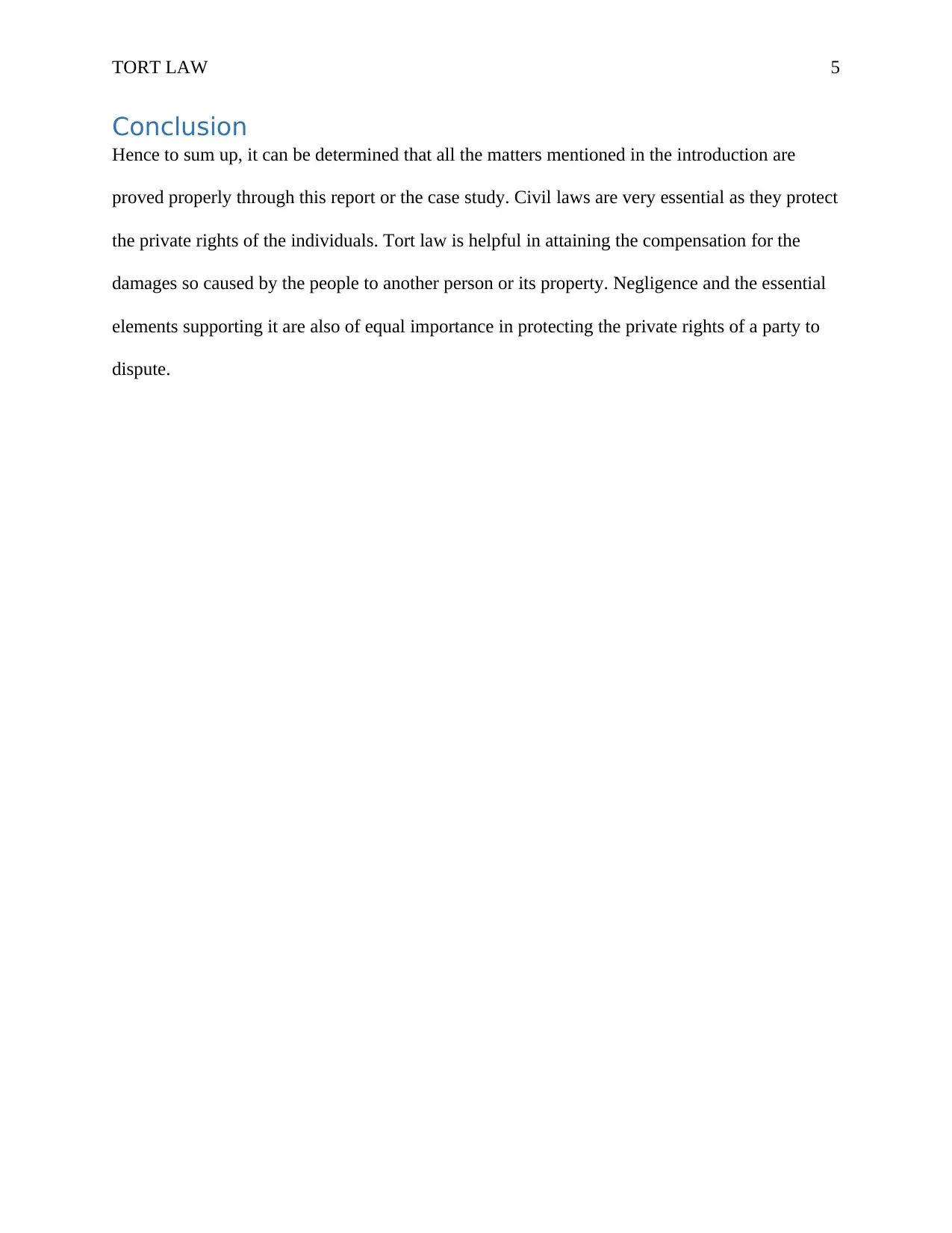
TORT LAW 5
Conclusion
Hence to sum up, it can be determined that all the matters mentioned in the introduction are
proved properly through this report or the case study. Civil laws are very essential as they protect
the private rights of the individuals. Tort law is helpful in attaining the compensation for the
damages so caused by the people to another person or its property. Negligence and the essential
elements supporting it are also of equal importance in protecting the private rights of a party to
dispute.
Conclusion
Hence to sum up, it can be determined that all the matters mentioned in the introduction are
proved properly through this report or the case study. Civil laws are very essential as they protect
the private rights of the individuals. Tort law is helpful in attaining the compensation for the
damages so caused by the people to another person or its property. Negligence and the essential
elements supporting it are also of equal importance in protecting the private rights of a party to
dispute.
⊘ This is a preview!⊘
Do you want full access?
Subscribe today to unlock all pages.

Trusted by 1+ million students worldwide
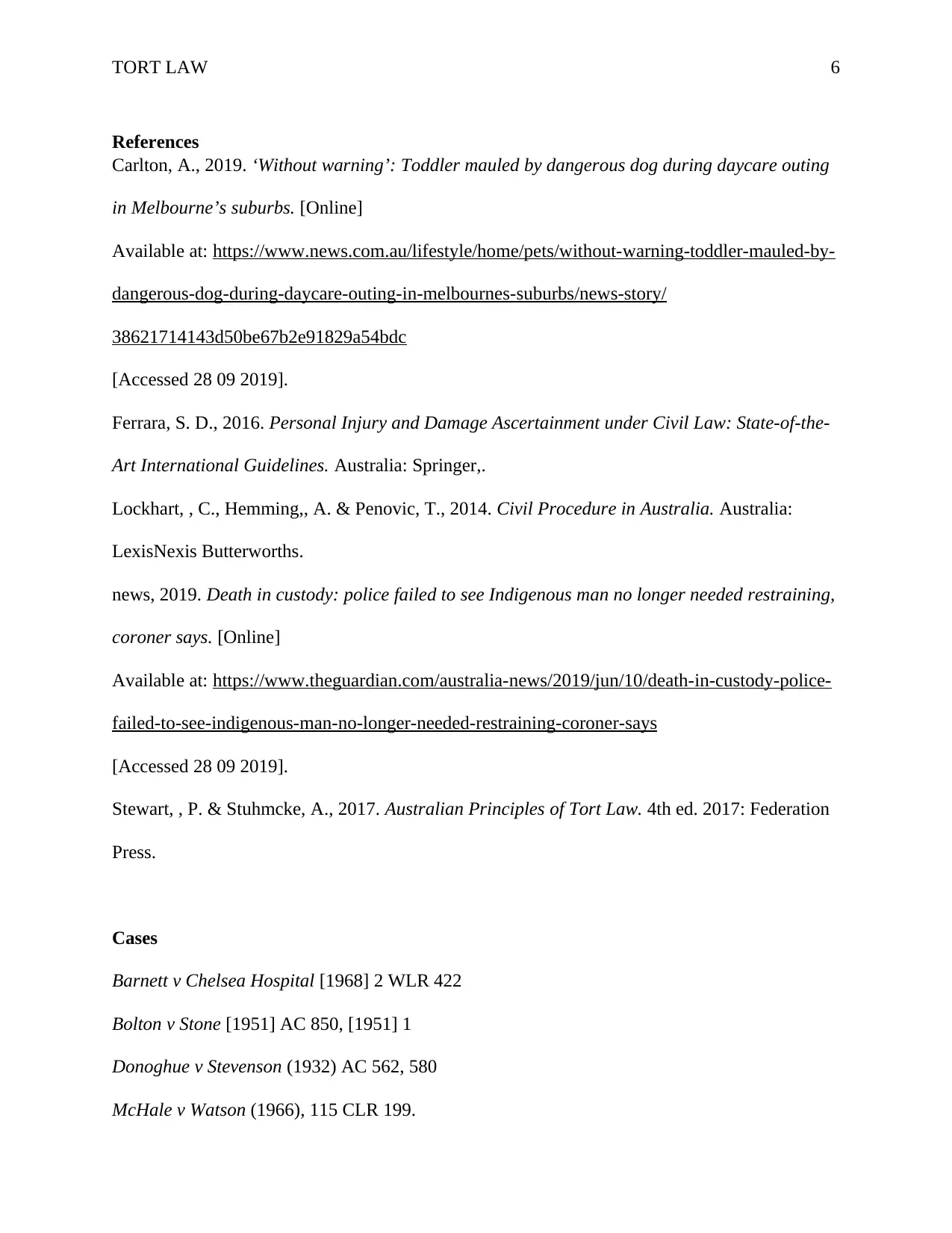
TORT LAW 6
References
Carlton, A., 2019. ‘Without warning’: Toddler mauled by dangerous dog during daycare outing
in Melbourne’s suburbs. [Online]
Available at: https://www.news.com.au/lifestyle/home/pets/without-warning-toddler-mauled-by-
dangerous-dog-during-daycare-outing-in-melbournes-suburbs/news-story/
38621714143d50be67b2e91829a54bdc
[Accessed 28 09 2019].
Ferrara, S. D., 2016. Personal Injury and Damage Ascertainment under Civil Law: State-of-the-
Art International Guidelines. Australia: Springer,.
Lockhart, , C., Hemming,, A. & Penovic, T., 2014. Civil Procedure in Australia. Australia:
LexisNexis Butterworths.
news, 2019. Death in custody: police failed to see Indigenous man no longer needed restraining,
coroner says. [Online]
Available at: https://www.theguardian.com/australia-news/2019/jun/10/death-in-custody-police-
failed-to-see-indigenous-man-no-longer-needed-restraining-coroner-says
[Accessed 28 09 2019].
Stewart, , P. & Stuhmcke, A., 2017. Australian Principles of Tort Law. 4th ed. 2017: Federation
Press.
Cases
Barnett v Chelsea Hospital [1968] 2 WLR 422
Bolton v Stone [1951] AC 850, [1951] 1
Donoghue v Stevenson (1932) AC 562, 580
McHale v Watson (1966), 115 CLR 199.
References
Carlton, A., 2019. ‘Without warning’: Toddler mauled by dangerous dog during daycare outing
in Melbourne’s suburbs. [Online]
Available at: https://www.news.com.au/lifestyle/home/pets/without-warning-toddler-mauled-by-
dangerous-dog-during-daycare-outing-in-melbournes-suburbs/news-story/
38621714143d50be67b2e91829a54bdc
[Accessed 28 09 2019].
Ferrara, S. D., 2016. Personal Injury and Damage Ascertainment under Civil Law: State-of-the-
Art International Guidelines. Australia: Springer,.
Lockhart, , C., Hemming,, A. & Penovic, T., 2014. Civil Procedure in Australia. Australia:
LexisNexis Butterworths.
news, 2019. Death in custody: police failed to see Indigenous man no longer needed restraining,
coroner says. [Online]
Available at: https://www.theguardian.com/australia-news/2019/jun/10/death-in-custody-police-
failed-to-see-indigenous-man-no-longer-needed-restraining-coroner-says
[Accessed 28 09 2019].
Stewart, , P. & Stuhmcke, A., 2017. Australian Principles of Tort Law. 4th ed. 2017: Federation
Press.
Cases
Barnett v Chelsea Hospital [1968] 2 WLR 422
Bolton v Stone [1951] AC 850, [1951] 1
Donoghue v Stevenson (1932) AC 562, 580
McHale v Watson (1966), 115 CLR 199.
1 out of 7
Related Documents
Your All-in-One AI-Powered Toolkit for Academic Success.
+13062052269
info@desklib.com
Available 24*7 on WhatsApp / Email
![[object Object]](/_next/static/media/star-bottom.7253800d.svg)
Unlock your academic potential
Copyright © 2020–2025 A2Z Services. All Rights Reserved. Developed and managed by ZUCOL.




